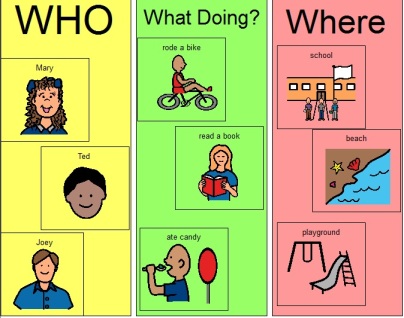Some of my students have difficulty with working memory and receptive language (or auditory processing, or whatever else you may call it) and this makes answering questions based on simple stories and events almost impossible. I find that including visual supports and starting at the simplest parts of a sentence/question can help build up confidence to complete harder tasks.
I put together a simple color-coded board to work on a 3 part “subject—-verb-object—–location” sentences with the “verb-object” part connected. I find that it sometimes creates a more salient image in students minds to have both the verb and object paired together, because if they are able to recall one it may be a trigger/cue for the other. This helps answer the “what doing?” questions.
What I try to do when using visual is give specific instructions so students can make associations between the visual input they are seeing and the auditory input they are hearing.
This is the hierarchy that I move up and down on depending upon the child’s skills. EACH OF THESE STEPS SHOULD BE REPEATED FOR PRACTICE MANY TIMES UNTIL A STUDENT MAKES THE CONNECTION AND POINTS TO/ANSWERS INDEPENDENTLY. I make it a point reinforce their correct responses by repeating what they say. I praise them with their response as a part of the praise. (“eat the cookie”; “You’re right, you answered what she is doing, she is eating the cooking”)
- “When I say ‘WHO’ you point to the yellow and say ‘_persons name/subject_’ “
- ” _subject_, WHO did I say? “
- “”When I say ‘what is subject doing’ you point to the green and say ‘_verb+object_’ ” *I accept “verb” or a point to the corresponding correct picture in the response.
- ” _verb+object_, What is the boy/girl doing?”
- ” ‘subject verb object‘ , ‘Who is verb objecting?’ “
- With the same picture sequence as in step 5, “What is subject doing?”
- “When I say ‘WHERE’ you point to the pink and say ‘location‘ “
- “location, WHERE?”
- Present the “Subject+Location” phrase and ask subsequent questions “who, where? questions.
- Present the “Subject, What doing, and Location” phrase with subsequent “What+What doing+Where” questions.


